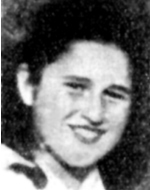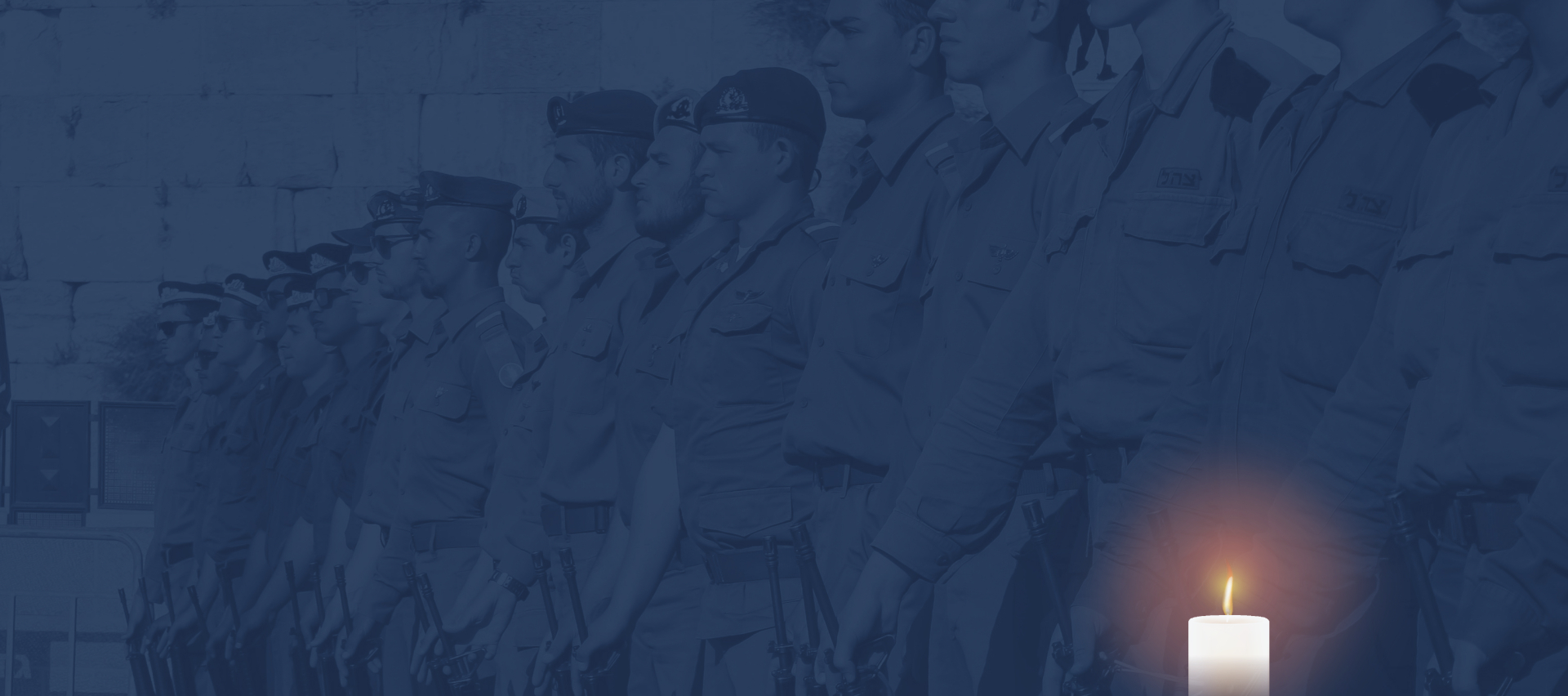,אֵ-ל מָלֵא רַחֲמִים, שׁוכֵן בַּמְּרומִים, הַמְצֵא מְנוּחָה נְכונָה
,עַל כַּנְפֵי הַשְּׁכִינָה בְּמַעֲלות קְדושִׁים, טְהורִים וְגִבּורִים
כְּזֹהַר הָרָקִיעַ מַזְהִירִים, לְנִשְׁמות חַיָּלֵי צְבָא הֲגָנָה לְיִשְׂרָאֵל


,אֵ-ל מָלֵא רַחֲמִים, שׁוכֵן בַּמְּרומִים, הַמְצֵא מְנוּחָה נְכונָה
,עַל כַּנְפֵי הַשְּׁכִינָה בְּמַעֲלות קְדושִׁים, טְהורִים וְגִבּורִים
כְּזֹהַר הָרָקִיעַ מַזְהִירִים, לְנִשְׁמות חַיָּלֵי צְבָא הֲגָנָה לְיִשְׂרָאֵל


Atara, the daughter of Rivka and Avigdor Abramson, was born on 28.12.1926 in Poland, in the town of Wielun in the Lodz District. Daughter of a well-known Hasidic family. She was educated in a religious school, and attended an elementary school in her native town of Wielun, located in southwestern Poland, about 100 kilometers from the city of Lodz. Many of the Jews who lived there traded, distributed industrial products, and bought agricultural produce from the village population. At the beginning of the twentieth century, the Enlightenment began to penetrate Wielun, and this was reflected, inter alia, in secular Jewish education. The Jewish population grew steadily and on the eve of World War II reached about 4,200 people. The Jewish community developed, a book company and a Jewish bank were established, and Zionist organizations began to operate. The Jewish library was an important cultural center in the town, and next to it was a sports club and a drama club. As the town was distanced from the main railway routes, a group of Jews initiated the construction of a permanent bus line between Wielun and Lodz. In the 1930s, antisemitism increased in Wielun. The economic boycott led to the gradual impoverishment of the Jews and the community institutions began to organize for mutual aid activities. At the end of the 1930s, acts of provocation increased, such as throwing stones at the synagogue. Wielun was completely destroyed during the first two days of the outbreak of World War II (September 1939) due to heavy bombardments, and many Jews fled. Most of them returned after the conquest of Warsaw and lived in the ruins of the houses or in the barracks. They were joined by many refugees who came to the town. Many Jews were arrested, and the men were abducted for forced labor in camps in the Poznan area or even in German territory. In the framework of the “intimidation campaigns” organized by Himmler, the Jewish community in Wielun suffered acts of terror and murder that included public hanging. One occurred on January 6, 1942, when the Nazis publicly hung ten Jews. In April 1942, 2,000 people were taken from Wielun and sent to an unknown location. Thousands of Jews were deported to Chelmno, and about 900 were transferred to the Lodz ghetto. Four months later, the liquidation of the Wielun ghetto took place. First the hospital patients were murdered and those who tried to hide were shot to death. The Jews of the ghetto were ordered to report to the town square and from there were taken to the local church, where they were kept crowded and crowded for four days. In accordance with the decisions of the Wannsee Conference, in which the assassinations were agreed upon gradually, a selection was made, and those who were not selected for forced labor were transported to Chelmno, where they were murdered in gas trucks. Atara’s extensive family was destroyed in the Holocaust, but she survived. At first she was exiled to internment camps in Germany, then brought to Auschwitz death camp and tortured there in terrible agony, but survived. After the liberation in 1945, Atara joined the religious group of the Nocham (United Pioneering Youth) movement, a movement that united Jewish youth from all the Zionist parties in an effort to immigrate to Eretz Israel and live a fulfilling life Nocham established a number of training farms in Germany, and in one of them they stayed for a while. Later she moved with the members of the movement to Italy. After another wandering, in the spring of 1946, she joined the “Ayala” group of the Bnei Akiva religious youth movement, a group that began temporary training in Italy, in Vilamadona, near Alessandria. Atara found her place in the new group, studied Hebrew and participated in all cultural activities. Together with her friends, she boarded the “Yordei Hasira” ship on August 2, 1946. The ship, which was organized by the Mossad Le’Aliyah Bet of the Haganah, sailed from the port of Boca di Magra in Italy with 790 immigrants from Eastern and Central Europe , Members of various youth movements, arriving in the region of CyprusWas discovered by a reconnaissance aircraft, and a destroyer of the Royal Navy seized the ship and towed it to the port of Haifa. The immigrants began a hunger strike in protest against their expected deportation, but after a violent struggle they were forcibly loaded onto a British ship and taken to camps in Cyprus. Atara and her friends spent six months in a camp in Cyprus. She only arrived in Israel at the end of February 1947. Her relatives urged her to stay with them, but when she was enthusiastic about kibbutz life, she decided to join Kfar Etzion, which was founded by members of her movement back in Galicia in 1934. Soon she was absorbed in the place and in society, and began to acquire confidence in the Hebrew language. Kfar Etzion was the first in the Gush Etzion settlements in the Lev of Mount Hebron. According to the United Nations partition resolution, the decision of November 29, 1947, Gush Etzion was not included within the boundaries of the Jewish state. Immediately after the decision, the Arabs of the area launched attacks on the Gush and the roads to it, and besieged it from all sides. The battle for Gush Etzion was perceived as part of the battle for Jerusalem. Therefore, the bloc was prepared to fight weapons, fortifications and fighters. All the members of the Gush, including the Haganah, served in the Jerusalem district of the Haganah, which later became the Etzioni Brigade, the “Jerusalem” Brigade (Division 6). The Haganah reinforced the bloc with fighters from the Harel Brigade of the Palmach and from the Haganah’s Field Corps from Jerusalem and Tel Aviv. During the next six months of battle, Gush Etzion was besieged, an isolated island of Jewish settlement in hostile territory. The connection with the settlers was preserved thanks to a number of vehicles that broke through from Jerusalem, especially during the first months of the blockade, mostly with the help of British security, and thanks to a few light aircraft using an improvised landing site. From time to time, a small quantity of supplies and weapons were sent to Gush Katif, sent by the Hagana headquarters. During the siege of Kfar Etzion, Atara underwent training in weapons, completed first aid courses, and took part in guarding. She showed great courage, was serious and responsible in the work, she was rooted to the spot, alert to every call, taking care of the wounded with care and tenderness. Because of the control of Gush Etzion on the road between Hebron and Jerusalem, the regular Jordanian army (the Arab Legion) launched a fierce offensive against it before the end of the British Mandate and the departure of the British from the country. On May 12, 1948, the Jordanian Legion began a powerful attack on the bloc’s strongholds and managed to locate it in two. The next day, on May 13, 1948, the Legion broke through the fortifications of Kfar Etzion, followed by crowds of Arabs from nearby villages, who were ordered to stop the fire and give in and concentrate near the school building, And others managed to escape to the basement of the German monastery, where they tried to continue fighting, and the Arabs, who could not penetrate the shelter, threw in many grenades and finally blew up the building. The residents of the building were buried to death under the rubble, and approximately 130 defenders of Kfar Etzion fell on the same day. “H (14 May 1948), the day the state was declared, surrendered three other defenders of Gush Etzion settlements: layers, beacons Isaac and eye Zurim. On this day the Gush ceased to exist and the remnants of its defenders went to the Jordanian captivity. They were the ones who reported Atara’s death to representatives of the Red Cross. Atara was twenty-one years old in the fall. The bodies of the fallen remained there for about a year or more. Their remains were collected in 1949 by a special operation of the military rabbinate. Atara was brought to rest with the rest of Gush Etzion in a large mass grave on Mount Herzl in Jerusalem, at a state ceremony held on the 17th of Cheshvan 5710 (17.11.1949). This hero is a “last scion”. The fallen of “Last Netzer” are Holocaust survivors who remained the last remnant of the family(Parents, brothers, sisters, sons and daughters) who experienced the Holocaust in the ghettos and / or the concentration and extermination camps and / or in flight and hiding in Nazi-occupied territories and / or fighting alongside members of the underground or Nazi-occupied territories During and after World War II, they wore uniforms and fell in the ranks of Israel.

